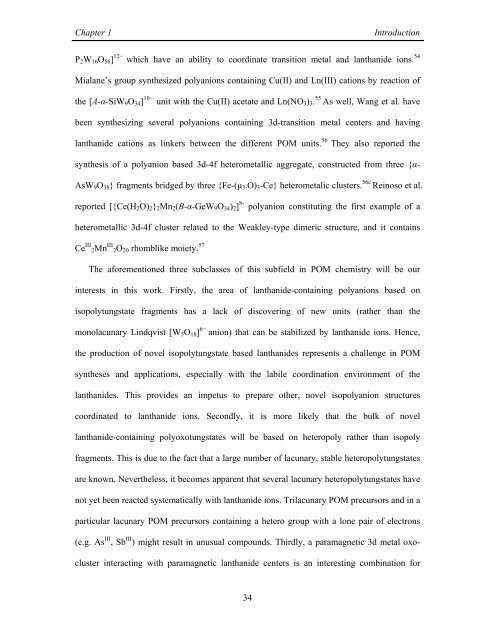Synthesis and Structural Characterization of ... - Jacobs University
Synthesis and Structural Characterization of ... - Jacobs University
Synthesis and Structural Characterization of ... - Jacobs University
Create successful ePaper yourself
Turn your PDF publications into a flip-book with our unique Google optimized e-Paper software.
Chapter 1<br />
Introduction<br />
P 2 W 16 O 56 ] 12− which have an ability to coordinate transition metal <strong>and</strong> lanthanide ions. 54<br />
Mialane’s group synthesized polyanions containing Cu(II) <strong>and</strong> Ln(III) cations by reaction <strong>of</strong><br />
the [A-α-SiW 9 O 34 ] 10− unit with the Cu(II) acetate <strong>and</strong> Ln(NO 3 ) 3 . 55 As well, Wang et al. have<br />
been synthesizing several polyanions containing 3d-transition metal centers <strong>and</strong> having<br />
lanthanide cations as linkers between the different POM units. 56 They also reported the<br />
synthesis <strong>of</strong> a polyanion based 3d-4f heterometallic aggregate, constructed from three {α-<br />
AsW 9 O 38 } fragments bridged by three {Fe-(μ 3- O) 3 -Ce} heterometalic clusters. 56c Reinoso et al.<br />
reported [{Ce(H 2 O) 2 } 2 Mn 2 (B-α-GeW 9 O 34 ) 2 ] 8- polyanion constituting the first example <strong>of</strong> a<br />
heterometallic 3d-4f cluster related to the Weakley-type dimeric structure, <strong>and</strong> it contains<br />
Ce III 2Mn III 2O 20 rhomblike moiety. 57<br />
The aforementioned three subclasses <strong>of</strong> this subfield in POM chemistry will be our<br />
interests in this work. Firstly, the area <strong>of</strong> lanthanide-containing polyanions based on<br />
isopolytungstate fragments has a lack <strong>of</strong> discovering <strong>of</strong> new units (rather than the<br />
monolacunary Lindqvist [W 5 O 18 ] 6− anion) that can be stabilized by lanthanide ions. Hence,<br />
the production <strong>of</strong> novel isopolytungstate based lanthanides represents a challenge in POM<br />
syntheses <strong>and</strong> applications, especially with the labile coordination environment <strong>of</strong> the<br />
lanthanides. This provides an impetus to prepare other, novel isopolyanion structures<br />
coordinated to lanthanide ions. Secondly, it is more likely that the bulk <strong>of</strong> novel<br />
lanthanide-containing polyoxotungstates will be based on heteropoly rather than isopoly<br />
fragments. This is due to the fact that a large number <strong>of</strong> lacunary, stable heteropolytungstates<br />
are known. Nevertheless, it becomes apparent that several lacunary heteropolytungstates have<br />
not yet been reacted systematically with lanthanide ions. Trilacunary POM precursors <strong>and</strong> in a<br />
particular lacunary POM precursors containing a hetero group with a lone pair <strong>of</strong> electrons<br />
(e.g. As III , Sb III ) might result in unusual compounds. Thirdly, a paramagnetic 3d metal oxocluster<br />
interacting with paramagnetic lanthanide centers is an interesting combination for<br />
34

















